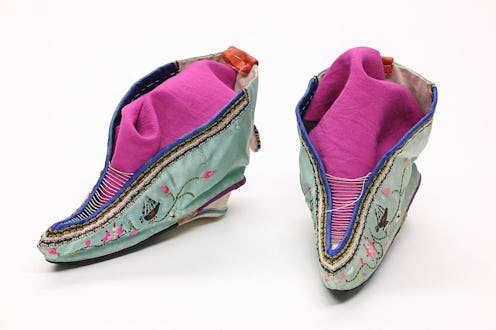Fashion
5 Crazy Ancient Shoe Trends You Won't Believe

Can you imagine getting up in the morning, picking out the perfect outfit and then leaving the house... barefoot? Of course not. But until 1500 BC (the first time that they were depicted in hieroglyphics), shoes were pure science fiction and humans had to rely on calluses to keep them safe. Eventually, footwear became the norm protecting kings, queens, merchants, and laborers from the elements. Of course, as they became more common the ruling classes developed styles to set their shoes apart. If you thought that Birkenstocks and D'Orsay stilettos were bad, just wait until you get a look at some ancient shoe trends.
And I'm not talking about your grandmother's "ancient" ballet flats. I'm talking ancient ancient. Think clay huts, golden castles, and dragons! No, not dragons. There were never any dragons. But still. These shoes are old. Real old.
Today, our shoe choices are as endless as they are (sometimes) practical, but throughout history we've had to keep our toes covered based on social rank and available materials. While we often turn to the past for fashion inspiration (looking at you gladiator sandals!) these five early shoes probably won't be walking down the runways anytime soon.
Leather Sandals
In Ancient Egypt, leather sandals were color coded according to class; dignitaries wore pastels and the middle class wore plain yellow and red. Of course, gold leather and jewels were saved for the Pharaoh and his court. Over time, the king upped his style game with pointed sandals that peaked over the foot... sort of like an elf. The peaked style was a clear sign of power since only the wealthy could afford to use the extra leather for embellishments, not function.
Plant-Based Shoes
In South America, the Incas and Mayans didn't need much protection from cold feet, but they did need help navigating rocky terrains. Their solution? They created sandal-like gear from llama leather and woven, plant fiber straps tied to feet called usutas. Usutas had very short soles that covered only from the heel of the foot to the ball! Toes hung free so that you could still get a grip on the ground.
Heels In the Middle of the Shoe
What if high heels were in the middle of shoes? This was the basic idea behind the chopine — a platform sole that attached to the bottom of shoes. This style, popular for nearly three centuries, was originally designed to keep clothing from dragging in the mud and dirt on the street. Women had to balance precariously on the balls of their feet and often needed a cane just to walk. Unfortunately, the city-state of Venice had to ban them after numerous pregnant women fell over and miscarried.
Triangle-Shaped Shoes
Meanwhile, in China, women strived for tiny "lotus feet" that they covered with three-cun lily feet shoes. These tiny, almost triangle shaped shoes were designed for enhancing bound feet and often made from metals or wood and decorated with silks. The tradition of foot binding often left women in severe pain for most of their lives so they could only walk short distances. I can't imagine that having metals strapped to feet made it any easier. And you thought your platforms were heavy!
Ridiculously Pointed Shoes
During the 14th century, European monarchs took to mocking the Polish over their long, pointed shoes known as the poulaine. Shoes of the wealthy (peasant shoe lengths were heavily regulated and kept short) became so ridiculously long that they were supported by pieces of whale bone. Legend has it that the poulaine went out of fashion after the Battle of Nicopolis, when French soldiers were unable to run away... until they cut off the front of their shoes. Talk about a losing battle.
Images: Wikimedia Commons